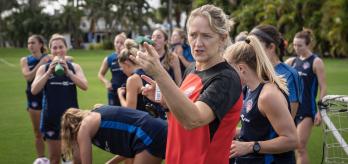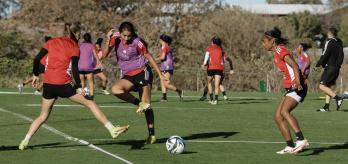Women’s football has made great strides in recent years, and the game is professionalising at a rapid rate. Nevertheless, the specific physical demands of the women’s game are still under-researched, with many clubs lacking the tools to conduct thorough analysis in this area. This in turn results in a knowledge gap that has significant repercussions for talent development. In this presentation, hosted by FIFA’s Hannu Tihinen, Dr Stacey Emmonds of Leeds Beckett University outlines how the FA’s Demands of the Game project is giving clubs the data they need to optimise their academy setups.
Good practice
- In order to prepare academy players for the senior game, you have to understand the physical demands being placed on youth players and how they match up to the those of elite football.
- Ensure that training is sufficiently intense to prepare players for match play.
- Set up systems for monitoring players’ development and injury histories – then use the data they give you to address factors relevant to athlete development.
Watch presentation
Read summary
Part 1: Introductions and background
The FA’s Demands of the Game project for women’s football was conceived as coaches and researchers began to recognise that there was a major “performance gap” between the demands of the domestic game and the requirements of international women’s football. This was compounded by a pronounced lack of knowledge regarding the physical demands being placed on youth players in academies. To investigate this issue, the FA brought in two PhD students – Dr Naomi Myhill and Dr Jake Beech – to examine the locomotor characteristics and physical profiles of elite women’s academy players.
Part 2: Locomotor skills and peak physical demand in academy players
To investigate the locomotor skills of elite female players, the research team examined 257 players across 11 different academy teams. When they compared data from the Barclays Women’s Super League (WSL) and Barclays Women’s Championship with statistics from the academies, they found that WSL players were exposed to far more high-speed running and sprinting than academy players, and that there was also a big difference in peak physical demand during games between the academies and senior professionals. This data served to illustrate just how difficult it can be for youngsters to make the physical step up to the senior game.
Part 3: The intensity of training drills
To better understand how the demands of competition were being reflected on the training pitch, the team turned their attention to the training drills to which players were exposed. Their findings showed that academy training was significantly less physically intense than match play, and that coaches often looked to increase intensity in training simply by making drills longer, rather than by manipulating the constraints associated with the exercises. This discovery led the team to create new tools and materials to help coaches tailor the physical demands of their sessions more effectively.
Part 4: Physical profiling and injuries
At the time of the project, few clubs had the capacity to understand the athletic development of their players and monitor injuries systematically. With that in mind, the research team used over 3,000 individual observations to develop interactive injury and physical profile dashboards that allowed coaches to examine data for their own players and compare it against the league average. The dashboards have been particularly useful for assessing the progress of individual players. Moreover, analysing the underlying data allows coaches to learn about the effects of puberty in young female players and the associated implications for athletic development.
Part 5: How girls develop and implications for football
A decrease in physical performance is observed around puberty. Yet, the physical demands of the game become more intense as players progress through the age groups, and very few academy training sessions replicate the physical loads experienced during matches. This combination of factors can leave female players vulnerable to injuries. As Emmonds explains, there is huge discrepancy between boys and girls in their exposure to strength and conditioning training. Could changing our approach in this area help female athletes to unleash their potential?
Part 6: Conclusion and Q&A
Finally, Dr Emmonds highlights some of the ways in which the 7-person research team has disseminated its findings to clubs and coaches, including by producing a number of webinars and a series of infographics. The session concludes with a Q&A (from 01:25) in which she discusses how clubs are using the research to inform their training sessions, how coaches are applying the latest insights on growth and maturation in female players, and the implications of the team’s research for the future of talent development in the women’s game.







